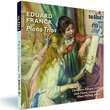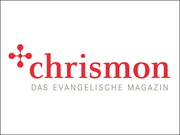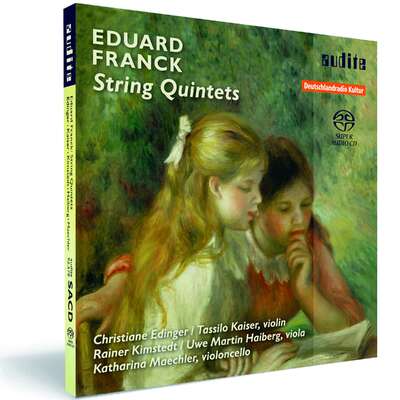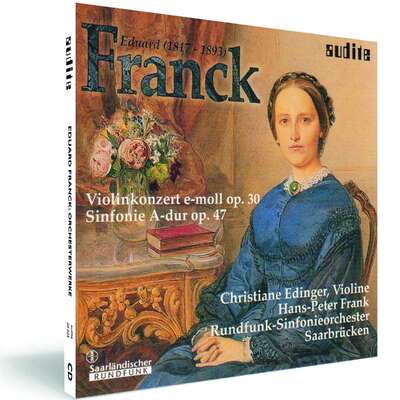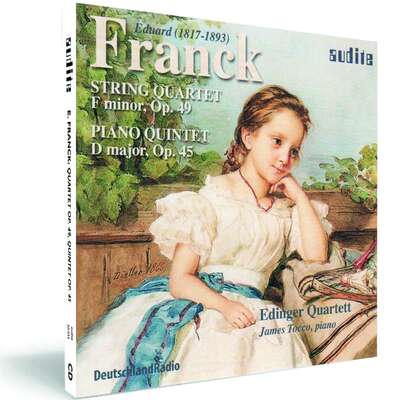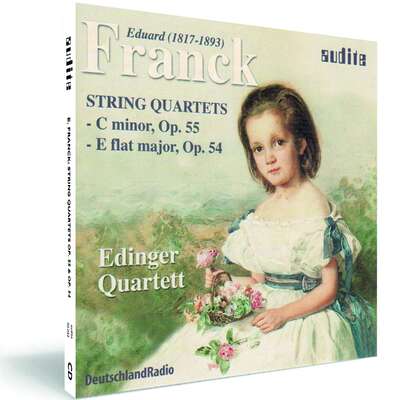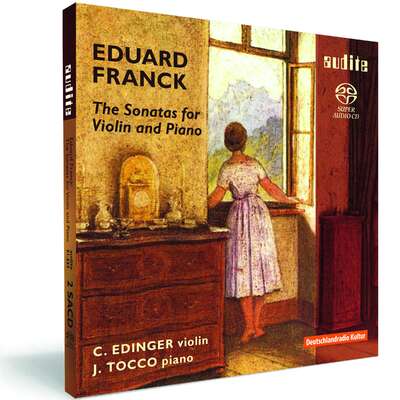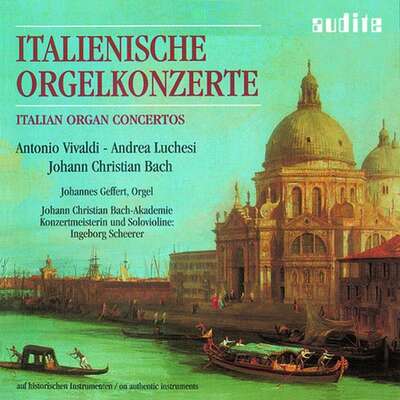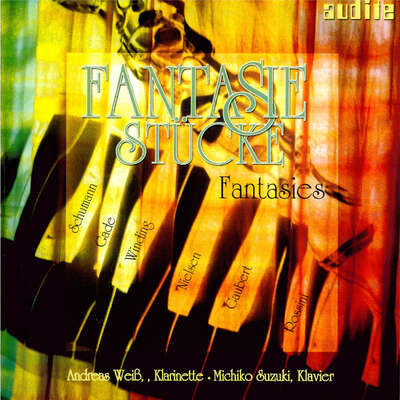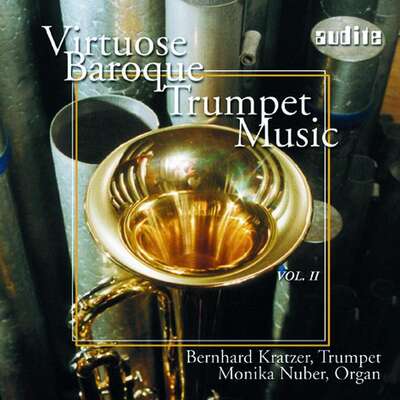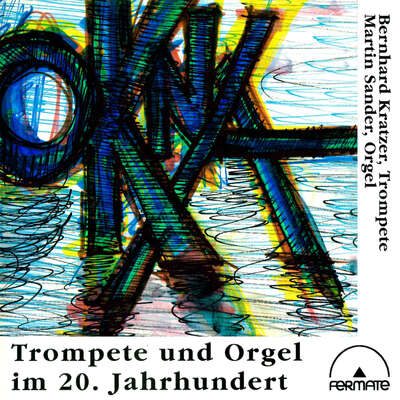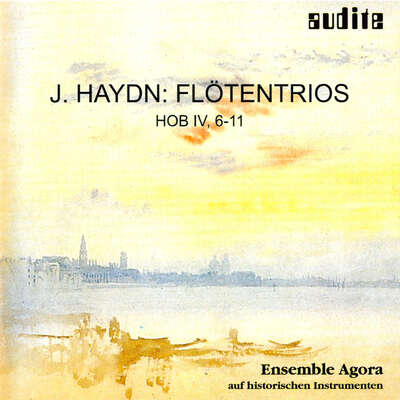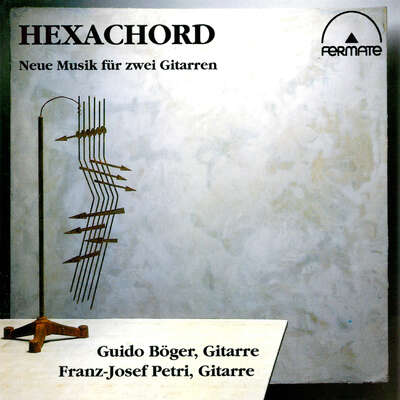
Mit der vorliegenden SACD wird die Eduard-Franck-Reihe bei audite weiter fortgesetzt. Francks kammermusikalische Werke verfügen über besondere Qualitäten, die ihn zweifellos als bedeutenden Künstler ausweisen. Impulse für seine Kompositionen erhielt er von seinen Freunden Robert Schumann...mehr
"Wie schön, dass das Musiklabel Audite den romantischen Komponisten und Mendelssohn-Schüler wiederentdeckt hat! Kammermusik zum Träumen." (Chrismon)
Details
| Eduard Franck: Piano Trios | |
| Artikelnummer: | 92.567 |
|---|---|
| EAN-Code: | 4022143925671 |
| Preisgruppe: | ACX |
| Veröffentlichungsdatum: | 3. April 2009 |
| Spielzeit: | 76 min. |
Informationen
Mit der vorliegenden SACD wird die Eduard-Franck-Reihe bei audite weiter fortgesetzt. Francks kammermusikalische Werke verfügen über besondere Qualitäten, die ihn zweifellos als bedeutenden Künstler ausweisen. Impulse für seine Kompositionen erhielt er von seinen Freunden Robert Schumann und Felix Mendelssohn, seinem späteren Lehrer, und durch Formmodelle der Wiener Klassiker.
Die Klaviertrios op. 11 und op. 58 sind zwei klangintensive und substanzreiche Kammermusikwerke, die zu den reizvollsten Stücken Edurad Francks zählen. Sowohl die satztechnische Souveränität als auch die verwendete Palette an Ausdrucksmöglichkeiten ist eindrucksvoll.
Heute sieht man Eduard Franck als Vermittler zwischen den Generationen der Hauptmeister, als Übergang von Schumann und Mendelssohn zu Bruch, Brahms und Bruckner. Der Reichtum der wieder entdeckten Kompositionsschätze überrascht auch noch mehr als 100 Jahre nach seinem Tod. Aufnahmen seiner Kammer- und Orchestermusik, wie sie die audite-Reihe präsentiert, schärfen dafür Blick und Ohr.
Unter den Interpreten von internationalem Ansehen hat sich Christiane Edinger um Francks Werke sehr verdient gemacht. Zusammen mit dem Cellisten Lluís Claret und dem Pianisten Klaus Hellwig hat sie auch diese beiden Trios eingespielt.
Besprechungen
http://walboi.blogspot.de | Wednesday, July 10, 2013 | Harry van der Wal | 10. Juli 2013 New acquisition. Eduard Franck, Piano trios
I have heard quite some chamber music in my lifetime, but none that had such an effect on me. This is music that should not be far away from your player, for it provides some serious consolation. Very attractive music, I would go as far as proclaiming them masterworks. But what would good music be, if not likewise good performers play it? And a good sound perspective?<br /> <br /> Both these things are honoured in a way that needs applauding, and many encores in this time honoured institution that proclaims ones appreciation. Mehr lesen
Both these things are honoured in a way that needs applauding, and many encores in this time honoured institution that proclaims ones appreciation.
Klassieke zaken | DINSDAG 22 MEI 2012 | Katja Reichenfeld | 22. Mai 2012 Pianotrio’s
‘Groot, middelmatig en klein’: deze indeling werd ooit gemaakt door deMehr lesen
Scherzo | N° 248 - Enero 2010 | Emili Blasco | 1. Januar 2010
Del compositor Eduard Franck (1817-1893) nacido en Breslau y muerto enMehr lesen
Fanfare | Nov/Dec 2009 | Michael Cameron | 1. November 2009
No, this is not Cesar Franck, nor even a relative, nor, unfortunately, is his music nearly as effective as that of the French master. This disc of twoMehr lesen
In the D-Major Trio, the influences shift to Schumann and perhaps early Brahms. Harmonies are bit more advanced, yet still conservative for the era during which he composed. Melodies are more compact than in the earlier trio, and phrase lengths a measure less predictable. The slow movement has a moment or two of harmonic daring, but there is no follow-through that allows them dramatic weight. Again, the melodies are attractive but adorned with strangely dreary piano accompaniment. The frolicsome last movement bears the imprint of some of Brahms's rustic finales.
While there are many passages that are mildly effective, the trios as a whole are hampered by excessive length, a trait he perhaps borrowed from Schubert but could not manage nearly as well. Even in a first hearing, the ear is aware of unaltered repetitions and cookie-cutter structures.
It is hard to find fault with the view of this music heard through the fingers of the three musicians. They sound as though they have lived with the trios for more than just a recording session or two, and consistently play with sensitivity and insight. Their ensemble is secure and tightly integrated for the most part, though intonation from the strings is sometimes wanting, including a curious tendency to shrink leading tones to nearly the size of a quarter tone.
Those who have had their fill of the standard Romantic chamber music repertoire may wish to give Eduard Franck's music a listen. It certainly makes for pleasant, uncomplicated listening, but if you're looking for an unsung hero of the 19th century, you will most likely need to continue your search.
American Record Guide | September/October 2009 | French | 1. September 2009
Now here's the perfect gift for chamber music<br /> fans who have everything: the only available<br /> recording of two superbly performed and engi-<br /> neeredMehr lesen
fans who have everything: the only available
recording of two superbly performed and engi-
neered piano trios written in standard 19th-
century four-movement form by little-known
German composer Eduard Franck (1817-93).
Trio 1 in E minor (Opus 11) is a bit thin in
the first movement: rather than using counter-
point, all too often one instrument merely
repeats what another has just played. But in
the Adagio Franck exhibits his lovely gift for
melody, and the Scherzo with trio has the
infectiousness of Schubert and Schumann. By
IV I caught myself foot-tapping and swaying in
this fiddler's mini-feast.
By the time Franck wrote Trio 4 in D (Opus
58) his melodic phrases had become more
long-lined, his harmonic progressions more
imaginative and affecting, and his develop-
ment of ideas less imitative and more expan-
sive. The first movement is highly engaging,
the Scherzo playful, the Andante a Schubertian
"walking" tune, and IV a folk-inspired, Schu-
mannesque, really clever finale. I was com-
pletely engrossed from beginning to end.
And what players these are, each superb in
his or her own right: Edinger is never on
autopilot, lyrical but never dominating. Claret
understands how his cello line functions har-
monically and melodically. And Hellwig can
make even low bass chords and lines transpar-
ent and buoyant. But it is as an ensemble they
absolutely excel, shaping phrases with sensi-
tivity and deep expression as they balance
Franck's cleverly woven lines. They turn play-
fulness into buoyancy, and their grasp of har-
monic movement keeps the flow forward-
looking yet without any impetuousness.
These players are not sensationalists by
any means. Their approach is as modest as the
engineering, which serves up an utterly natur-
al, integrated, concert-hall palette without any
exaggerated effects. Both players and produc-
ers are at the full service of Eduard Franck—
sounds like a cliche, but this is one instance
where it's true.
fans who have everything: the only available
recording of two superbly performed and engi-
neered
Pianiste | Sept/Oct 2009 | O.E. | 1. September 2009 Eduard Franck
Professeur, concertiste, élève de Mendelssohn, Eduard Franck (1817-1893)Mehr lesen
Diapason | Septembre 2009 N° 572S | Jérôme Bastianelli | 1. September 2009
Pianiste et compositeur, Eduard Franck fut l'élève de Mendelssohn à Düsseldorf et à Leipzig. Ses trios, comme les œuvres de musique de chambreMehr lesen
Pizzicato | N° 195, 9/2009 | Rémy Franck | 1. September 2009 Wunderschöne Kammermusik
Ist das doch schöne Musik! Liebliche Melodik und sanfte Rhythmen wiegen den Zuhörer zunächst durch die beiden ersten Sätze des Trios op. 11. UndMehr lesen
Die Geigerin Christiane Edinger und ihre beiden Kollegen Lluís Claret am Cello und Klaus Hellwig am Klavier stellen sich völlig in den Dienst der Musik, der sie technisch wie auch im Ausdruck und in der Vermittlung von Gefühlen komplett gerecht werden, und das mit einer bemerkenswerten Justesse.
International Record Review | September 2009 | Calum MacDonald | 1. September 2009
E. Franck
Piano Trios – E minor, Op. 11; D, Op. 58
Entirely unrelated to César Franck, the German composer Eduard Franck (born in Breslau in 1817, died in Berlin in 1893) was a pupil of Mendelssohn, aMehr lesen
Franck composed a substantial amount of chamber music, including five piano trios; the two on this SACD are the first and last of the three that were published, and apparently Nos. 2 and 5 in order of composition, though in fact the dates of some of these works are not fully established. The E minor Trio at least was published in Berlin in 1848, and the D major exactly 50 years later – posthumously – under the editorship of Franck's son. Despite the wide divergence in their opus numbers they do not manifest any huge stylistic development, though the D major is clearly the later and better work. It would be true to say that the E minor, clearly post-Classical in its ambience, was a rather conservative utterance for 1848, while the D major would clearly be downright old-fashioned for the late 1880s or early 1890s, if that is when it was composed.
There is a great deal of attractive music here, but I did not feel I was discovering the work of a forgotten master. Franck was a much more than competent composer whose basic idiom, redolent of Mendelssohn, Schubert and Schumann, reveals occasional touches of originality and yields some charming melodic ideas. These works (especially the D major) would certainly merit occasional revival but they hardly prompt the idea that the history of nineteenth-century music, even nineteenth-century chamber music, is in urgent need of revision. In the first two movements of the E minor one notes an over-reliance on sequence and phrase repetition, and a use of passing chromaticism for purposes of sentimental pathos that comes to seem a recurrent trait. However, matters improve greatly with a lively Scherzo, which has a folk dance/drone trio, and the finale.
I have a sort of theory that, in a sonatabased genre, it's often in the finales –frequently viewed by critics as the quick movement tacked on to the rest because the piece has to end somehow – that minor composers of the romantic era are better able to show their quality and individuality than elsewhere. It takes real mastery to handle a sonata-form first movement effectively, and genius to do something really original with it. Yet in finales the range of acceptable forms and strategies is much larger even than in slow movements, and elements of fantasy and caprice are positively encouraged; thus the composer feels correspondingly more relaxed, less constrained by history, and can do his own thing without looking over his shoulder at how Beethoven or Mozart did it. Anyway, Franck's finale starts with an ebullient violin cadenza and develops a fine surging, optimistic motion of its own, with the violin emerging at more reflective points as a kind of soloist. Franck makes effective use of sonorous pedalpoints and witty dialogic inversions to create a thoroughly enjoyable movement.
The D major Trio is a broader, more genial, more relaxed work, and one altogether richer in Affekt. Franck seems to have had the Schubert Trios in mind, especially in the ample first movement, which wears its sonata architecture lightly and has pastoral, countrydance touches. In this work the Scherzo comes second and is a splendid one, in hunting style – one thinks of the Scherzo of the Brahms Horn Trio – with a hymn-like trio. If the slow movement strays into the realm of the salon or the palm court, it does so in rather gorgeous terms, the violin and cello raptly participating in a romantic, operetta-ish duet. The finale sets off as a kind of zany country dance with drone fifths and is so obviously humorously intended – Franck extending the tradition of Haydn's 'alla Zingaresca' finales – that it's difficult to be sure if a couple of seeming infelicities are intentional, or simple miscalculations. For instance, one of the principal 'folk-like' tunes rounds itself off with a wildly over-elaborate quasi-cadential flourish of semiquavers (or they could be demisemiquavers; I haven't seen a score) which may be intended to sound inebriated or cheeky but, especially when presented as it usually is by the cello, just sounds awkward to play. Even if this is a blemish, the movement as a whole has considerable charm and raffish panache.
The SACD recording is top-notch, and the players, among whom Christiane Edinger is probably the best known, of high quality. I certainly cannot imagine these pieces better performed. This is one for those interested in exploring the forgotten byways; if your expectations are not too high, you're unlikely to be disappointed.
Ensemble - Magazin für Kammermusik | 4-2009, August/September | Hans-Dieter Grünefeld | 1. August 2009 Ernster Charme
Als Student bei Felix Mendelssohn-Bartholdy wurde Eduard Franck keinMehr lesen
klassik.com | Juli 2009 | Dr. Stefan Drees | 26. Juli 2009 | Quelle: http://magazin.k... Eine verdiente Veröffentlichung
Wieder einmal macht sich das Label Audite um das Schaffen des RomantikersMehr lesen
abc artes | Junio 2009 | Juan Manuel Viana | 27. Juni 2009 E. Franck: Trios con piano
Como su maestro Mendelssohn. Eduard Franck (1817-1893) se crió en unaMehr lesen
Chrismon - Das evangelische Magazin | Juni 2009 | 1. Juni 2009
Wie schön, dass das Musiklabel Audite den romantischen Komponisten undMehr lesen
www.amazon.co.uk | May 2009 | J. A. Peacock | 6. Mai 2009 Beautifully written music of rustic charm and bitter-sweet Early Romantic hue
If you have been following and enjoying Audite's invaluable survey of Eduard Franck's work, you'll have been looking forward to this new release asMehr lesen
Franck seems to have composed in pretty much the same vein throughout his life and both these works contain his signature qualities - an abundance of attractive melody, occasional rustic overtones, bitter-sweet melancholy and a sure sense of structure. The music is conventional and content to work within an Early Romantic sense of classical form. As in his other recorded pieces, the scherzos are infectious and buoyant and the slow movements lyrical and, while not plumbing any great depth, often quite touching and tender.
The trio in E minor has an expansive opening `allegro', which the artists play at a relatively leisurely pace - they obviously placed due emphasis on the `moderato con espressione' markings; I would perhaps have preferred a little less indulgence, but there is much lovely music here, to linger over which isn't much of a problem. The finale opens strikingly with some florid solo violin writing and this sets the tone for an energetic and memorable finish to the work.
The D major trio opens with an allegro that feels more concisely argued and there is a fine development section that sets the seal on this satisfying movement. The scherzo is particularly delightful; as it trips merrily along, you might feel the composer's memory of a country dance is not far away. The `andante con moto' alternates two of Franck's loveliest melodic inspirations and the finale, with further rustic echoes (this time with a distinct reminiscence for modern day listeners of Haydn's Symphony No. 82 and its bear-dance finale), rounds off this later piece that - for all the charm of the earlier trio - is, I think, one of the composer's most accomplished chamber works.
The recording and the performances are generally very fine. There were a couple of occasions where I felt the violin was a touch acidic in tone, but I notice this less as I play through the disc - I don't know whether this is because the problem is limited to the first movement of the E minor trio or whether my ear simply becomes accustomed to it. In any case, it is certainly not issue enough to spoil this lovely music or for anyone to be concerned about acquiring this highly recommended disc.
WDR 3 | WDR3 Tonart | 05.05.2009, 15:05 | Julia Spykler | 5. Mai 2009 Klaviertrios von Eduard Franck
Unsicher beginnt der erste Satz des Klaviertrios in E-moll op. 11 vonMehr lesen
Diverdi Magazin | 181/mayo 2009 | Blas Matamoro | 1. Mai 2009
El otro Franck
Obras de cámara de un romántico semiolvidado, en Audite
Gracias a un libro publicado en 1993 y cuyos autores, Paúl y Andreas Feuchte, son bisnieto y tataranieto de Eduard Franck (1817-1893), podernos saberMehr lesen
Nacido en Breslau y muerto en Berlín, Franck corre un riesgo añadido y es que si no se aclara su nombre de pila, cabe confundirlo fácilmente con el colega y belga César. Además, sus obras circularon poco y alguna debió ser editada postuma, por gestión de su hijo Richard, ya mencionado.
Nuestro Franck estudió piano privadamente con Mendelssohn y frecuentó a Schumann en su tertulia a menudo también musical. La influencia del primero es notable en su catálogo, mayormente compuesto por títulos de cámara. Le importaron las formas y su desarrollo sucesivo. Fue respetuoso con los esquemas heredados. Pasó de lado junto a la "nueva Alemania de la música" o sea la de Liszt y Wagner, sin inmutarse por ella. Cumplió su menester con aplicación y denuedo, no siendo arriesgado adjetivarlo de mendelssohniano.
Estos tríos son de factura límpida, eficaz y honesta. Revelan al dueño de una escritura pianística consumada, a partir de la cual trabajan los compañeros del grupo. Sus melodías son comedidas y de sabio despliegue. Sin exagerar los matices, se oyen los colores, si cabe la figura, que sugieren las timbraciones de los distintos instrumentos. Franck se propuso saber de lo que sabía la música de su tiempo. Estas son las pruebas de haberlo conseguido.
